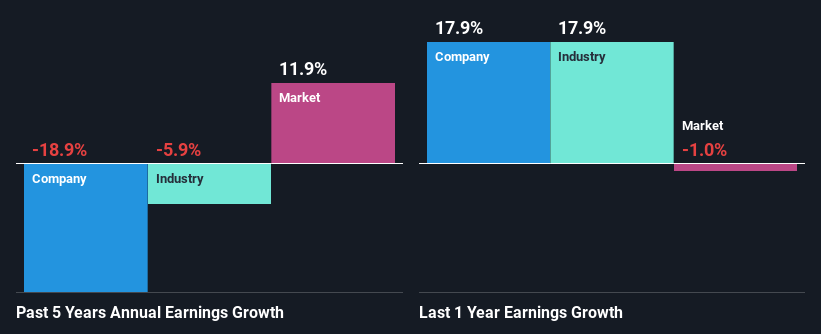- United Kingdom
- /
- Medical Equipment
- /
- LSE:SN.
Is Smith & Nephew plc's (LON:SN.) Stock On A Downtrend As A Result Of Its Poor Financials?
It is hard to get excited after looking at Smith & Nephew's (LON:SN.) recent performance, when its stock has declined 8.1% over the past three months. We decided to study the company's financials to determine if the downtrend will continue as the long-term performance of a company usually dictates market outcomes. In this article, we decided to focus on Smith & Nephew's ROE.
Return on Equity or ROE is a test of how effectively a company is growing its value and managing investors’ money. Simply put, it is used to assess the profitability of a company in relation to its equity capital.
Check out our latest analysis for Smith & Nephew
How Do You Calculate Return On Equity?
Return on equity can be calculated by using the formula:
Return on Equity = Net Profit (from continuing operations) ÷ Shareholders' Equity
So, based on the above formula, the ROE for Smith & Nephew is:
5.0% = US$263m ÷ US$5.2b (Based on the trailing twelve months to December 2023).
The 'return' is the yearly profit. So, this means that for every £1 of its shareholder's investments, the company generates a profit of £0.05.
What Is The Relationship Between ROE And Earnings Growth?
We have already established that ROE serves as an efficient profit-generating gauge for a company's future earnings. Based on how much of its profits the company chooses to reinvest or "retain", we are then able to evaluate a company's future ability to generate profits. Assuming everything else remains unchanged, the higher the ROE and profit retention, the higher the growth rate of a company compared to companies that don't necessarily bear these characteristics.
Smith & Nephew's Earnings Growth And 5.0% ROE
On the face of it, Smith & Nephew's ROE is not much to talk about. However, given that the company's ROE is similar to the average industry ROE of 5.8%, we may spare it some thought. But then again, Smith & Nephew's five year net income shrunk at a rate of 19%. Remember, the company's ROE is a bit low to begin with. Therefore, the decline in earnings could also be the result of this.
Furthermore, even when compared to the industry, which has been shrinking its earnings at a rate of 5.9% over the last few years, we found that Smith & Nephew's performance is pretty disappointing, as it suggests that the company has been shrunk its earnings at a rate faster than the industry.

Earnings growth is a huge factor in stock valuation. The investor should try to establish if the expected growth or decline in earnings, whichever the case may be, is priced in. This then helps them determine if the stock is placed for a bright or bleak future. Is SN. fairly valued? This infographic on the company's intrinsic value has everything you need to know.
Is Smith & Nephew Efficiently Re-investing Its Profits?
With a high three-year median payout ratio of 73% (implying that 27% of the profits are retained), most of Smith & Nephew's profits are being paid to shareholders, which explains the company's shrinking earnings. With only a little being reinvested into the business, earnings growth would obviously be low or non-existent. You can see the 3 risks we have identified for Smith & Nephew by visiting our risks dashboard for free on our platform here.
Moreover, Smith & Nephew has been paying dividends for at least ten years or more suggesting that management must have perceived that the shareholders prefer dividends over earnings growth. Upon studying the latest analysts' consensus data, we found that the company's future payout ratio is expected to drop to 43% over the next three years. As a result, the expected drop in Smith & Nephew's payout ratio explains the anticipated rise in the company's future ROE to 17%, over the same period.
Conclusion
On the whole, Smith & Nephew's performance is quite a big let-down. Because the company is not reinvesting much into the business, and given the low ROE, it's not surprising to see the lack or absence of growth in its earnings. Having said that, looking at current analyst estimates, we found that the company's earnings growth rate is expected to see a huge improvement. Are these analysts expectations based on the broad expectations for the industry, or on the company's fundamentals? Click here to be taken to our analyst's forecasts page for the company.
New: Manage All Your Stock Portfolios in One Place
We've created the ultimate portfolio companion for stock investors, and it's free.
• Connect an unlimited number of Portfolios and see your total in one currency
• Be alerted to new Warning Signs or Risks via email or mobile
• Track the Fair Value of your stocks
Have feedback on this article? Concerned about the content? Get in touch with us directly. Alternatively, email editorial-team (at) simplywallst.com.
This article by Simply Wall St is general in nature. We provide commentary based on historical data and analyst forecasts only using an unbiased methodology and our articles are not intended to be financial advice. It does not constitute a recommendation to buy or sell any stock, and does not take account of your objectives, or your financial situation. We aim to bring you long-term focused analysis driven by fundamental data. Note that our analysis may not factor in the latest price-sensitive company announcements or qualitative material. Simply Wall St has no position in any stocks mentioned.
About LSE:SN.
Smith & Nephew
Develops, manufactures, markets, and sells medical devices and services in the United Kingdom, the United States, and internationally.
Established dividend payer and good value.
Similar Companies
Market Insights
Community Narratives




